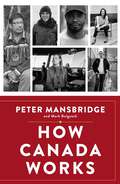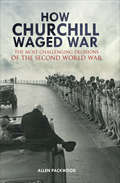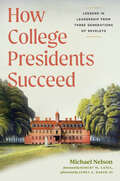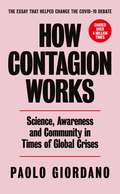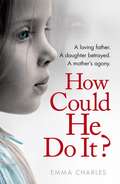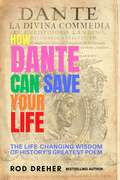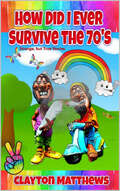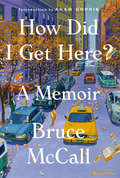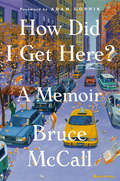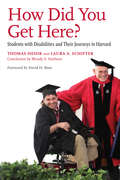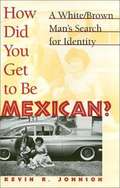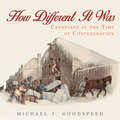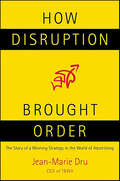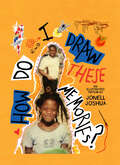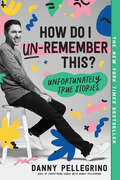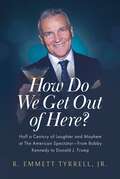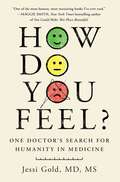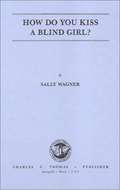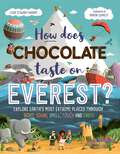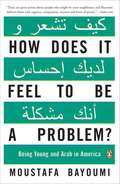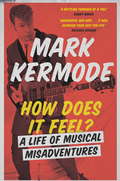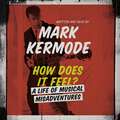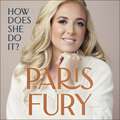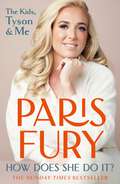- Table View
- List View
How Canada Works: The People Who Make Our Nation Thrive
by Peter Mansbridge Mark BulgutchFrom #1 bestselling authors Peter Mansbridge and Mark Bulgutch comes a new book of first-person stories about the unique people and professions that make Canada work.In this latest collection of personal stories, Peter Mansbridge and former CBC producer Mark Bulgutch shine a light on the everyday jobs that keep our nation running and the inspiring people who perform them with empathy and kindness. Meet the 911 operator in British Columbia who sends help to callers in crisis and stays on the line, steadying them as they wait. Hear from the chief of the Neskantaga First Nation in northern Ontario, who sacrifices his personal time to fight for better resources for his community, which has had a boil water advisory since the mid-1990s. From the air traffic controller who ensures people get to where they need to go, to the midwife in Saskatchewan who guides families through pregnancy and the birthing process, these are the jobs that connect Canadians on both a logistical and personal level. Though Canada is still very much a work in progress, this enlightening book celebrates how we are greater than the sum of our parts by championing the people that make our country great.
How Churchill Waged War: The Most Challenging Decisions of the Second World War
by Allen PackwoodAn analytical investigation into Prime Minister Winston Churchill&’s decision-making process during every stage of World War II. When Winston Churchill accepted the position of Prime Minister in May 1940, he insisted in also becoming Minister of Defence. This, though, meant that he alone would be responsible for the success or failure of Britain&’s war effort. It also meant that he would be faced with many monumental challenges and utterly crucial decisions upon which the fate of Britain and the free world rested. With the limited resources available to the UK, Churchill had to pinpoint where his country&’s priorities lay. He had to respond to the collapse of France, decide if Britain should adopt a defensive or offensive strategy, choose if Egypt and the war in North Africa should take precedence over Singapore and the UK&’s empire in the East, determine how much support to give the Soviet Union, and how much power to give the United States in controlling the direction of the war. In this insightful investigation into Churchill&’s conduct during the Second World War, Allen Packwood, BA, MPhil (Cantab), FRHistS, the Director of the Churchill Archives Centre, enables the reader to share the agonies and uncertainties faced by Churchill at each crucial stage of the war. How Churchill responded to each challenge is analyzed in great detail and the conclusions Packwood draws are as uncompromising as those made by Britain&’s wartime leader as he negotiated his country through its darkest days.
How College Presidents Succeed: Lessons in Leadership from Three Generations of Reveleys
by Michael NelsonLeadership lessons in higher education and what they can teach us about leadership in all walks of life In an era when college presidents serve for on average fewer than six years—leaving out of personal ambition for a next post or being forced to leave under fire—there is an inspirational counterexample of leaders dedicated to the long-term success of their institutions. This book weaves together the stories behind what the Washington Post dubbed &“Virginia&’s academic dynasty&” to determine what makes for sound and effective institutional leadership. Here are the lessons of three generations of college presidents from one family, the Reveleys, who have successfully led major colleges and universities across the commonwealth of Virginia for decades, an ongoing legacy unrivaled in modern American higher education. All three generations of Reveleys profiled here successfully dealt with the challenges of stewarding varied institutions—Hampden-Sydney College, William & Mary, and Longwood University—in a politically and demographically evolving state embedded within an equally dynamic and complex national, economic, and cultural environment for higher education. Now, in the Reveleys&’ own words—drawn from more than one hundred hours of oral interviews and thousands of pages of personal papers—this book tells their story and offers readers insights into best leadership practices gleaned from their unparalleled cumulative experience.
How Contagion Works: Science, Awareness and Community in Times of Global Crises - The short essay that helped change the Covid-19 debate
by Paolo Giordano'Lucid, calm, informed, directly helpful in trying to think about where we are now... The literature of the time after begins here' Evening Standard'Taking a breather from bewildering statistics and terrible tales of contagion to read Giordano's book was a jolt of brevity and simplicity... It takes concepts that have been dancing away in our minds, just out of reach, and lines them up neatly' The Times'Potent and original' Sunday Times'In one short hour, in the midst of this difficult moment, Giordano reinforced my sense of hope in humanity, in the one and the many' Philippe Sands, author of East West Street and The Rat LineThe Covid-19 pandemic is the most significant health emergency of our time.Writing from Italy in lockdown, physicist and novelist Paolo Giordano explains how disease spreads in our interconnected world: why it mattershow it impacts ushow we must reactExpanding his focus to include other forms of contagion - from the environmental crisis to fake news and xenophobia - Giordano shows us not just how the coronavirus crisis got so bad so quickly, but also how we can work together to create change.Paolo Giordano is a physicist and the author of four bestselling novels. His article 'The Mathematics of Contagion' - published in Italy at the beginning of the coronavirus emergency - was shared more than 4 million times and helped shift public opinion in the early stages of the epidemic.
How Could He Do It?
by Emma Charles'In many ways we were an ordinary family: mum, dad, two kids, three dogs, one rabbit, two guinea pigs. I stayed at home, studying with the Open University, and dad worked, and the kids went to private schools. We lived in a rather nice semi in a rather nice area of Edinburgh, with a rather nice Volvo in the drive, and took rather nice holidays, wearing rather nice clothes. I loved Daniel deeply and I thought - no, I was sure - he loved me deeply, too. And we both loved our kids deeply (I thought). And that was as it should be. We had it made.In some ways we weren't a completely ordinary family. There was Daniel, for one; he worked for most of the time we were married as a ship's engineer, and so he was away from home for up to four months and then home on leave for up to two. And Tamsin, our fifteen-year-old daughter, had specific learning difficulties. But I'm pretty ordinary: an unlikely heroine. I am disabled because of back problems. I'm pretty fat - I've put on a lot of weight through lack of exercise and, yes, comfort-eating! Not the stuff of movies.But I never for a moment dreamt that my family was all that extraordinary - until that day when Tamsin broke down and told me that her father, my loving husband, had been sexually abusing her.'
How Dante Can Save Your Life: The Life-Changing Wisdom of History's Greatest Poem
by Rod DreherThe opening lines of The Divine Comedy by Dante Alighieri launched Rod Dreher on a journey that rescued him from exile and saved his life. Dreher found that the medieval poem offered him a surprisingly practical way of solving modern problems.Following the death of his little sister and the publication of his New York Times bestselling memoir The Little Way of Ruthie Leming, Dreher found himself living in the small community of Starhill, Louisiana where he grew up. But instead of the fellowship he hoped to find, he discovered that fault lines within his family had deepened. Dreher spiraled into depression and a stress-related autoimmune disease. Doctors told Dreher that if he didn&’t find inner peace, he would destroy his health. Soon after, he came across The Divine Comedy in a bookstore and was enchanted by its first lines, which seemed to describe his own condition. In the months that followed, Dante helped Dreher understand the mistakes and mistaken beliefs that had torn him down and showed him that he had the power to change his life. Dreher knows firsthand the solace and strength that can be found in Dante&’s great work, and distills its wisdom for those who are lost in the dark wood of depression, struggling with failure (or success), wrestling with a crisis of faith, alienated from their families or communities, or otherwise enduring the sense of exile that is the human condition. Inspiring, revelatory, and packed with penetrating spiritual, moral, and psychological insights, How Dante Can Save Your Life is a book for people, both religious and secular, who find themselves searching for meaning and healing. Dante told his patron that he wrote his poem to bring readers from misery to happiness. It worked for Rod Dreher. Dante saved Rod Dreher&’s life—and in this book, Dreher shows you how Dante can save yours.
How Did I Ever Survive the 70's: Strange, but True Stories
by Clayton Matthews<p>Humorous personal essays detailing a teenaged boy’s coming of age in the 1970s, an era defined by sexual liberation and drug experimentation.<p> <p>Clayton Matthews, if that’s his real name, was a child of the ‘70s. He smoked pot, drove fast cars, and chased women. In this hilarious collection of essays detailing his misspent youth, Matthews looks back at a decade where bell bottoms, free love and LSD were all the rage. A self-proclaimed hippie from a small Midwestern town, Matthews’s no-holds-barred account of everything from sexual exploits to acid trips will have readers young and old relishing a time when the counterculture of the ‘60s had become the mainstream of the 70s, and sex, drugs and rock and roll were a way of life.<p>
How Did I Get Here?: A Memoir
by Bruce McCallFrom his hardscrabble post-World War II Ontario childhood and coming of age to Mad Men-era New York City and the creative pinnacle of advertising, to the hallowed halls of Saturday Night Live and The New Yorker, Bruce McCall&’s personal and creative journey is stunningly honest, bittersweet, and, above all, inspiring. Beloved for his strikingly original and wickedly perceptive New Yorker covers, as well as his many Shouts and Murmurs, Bruce is a rare double threat as an artist and writer. Self-taught in both disciplines, his artistic world has captured the imagination of a loyal fan base that includes no less than David Letterman (whom he coauthored a book with) and other satire aficionados. Pulling no punches, How Did I Get Here? chronicles the evolution of his artistic genius as well as his journey from gifted childhood scribbler to passionate automobile enthusiast, a hobby that took him to the heights of the Detroit and Manhattan advertising worlds. His long-held passion for drawing and writing, which mostly lay dormant during his Mad Men days, reemerged later in life as he left the realm of advertising for the world of arts and letters, most notably at the National Lampoon, as a writer for Saturday Night Live in its first incarnation, and then of course at The New Yorker, as well as other Conde Nast magazines, such as Vanity Fair. His is an unorthodox life and career path, traversing through worlds that have now become iconic, giving us rich first-hand insight into Bruce's unique creative development and process, and providing a rare window into both the highs and the lows that define an artist's career and life. With wit, candor, and cover illustrations showcasing Bruce's storied career, Bruce McCall&’s memoir will charm his many fans and anyone who knows and loves the places and eras he describes so well.
How Did I Get Here?: A Memoir
by Bruce McCallFrom his hardscrabble post-World War II childhood and coming of age in Ontario to Mad Men-era New York City and the creative pinnacle of advertising, to the hallowed halls of Saturday Night Live and The New Yorker, Bruce McCall&’s personal and creative journey is stunningly honest, bittersweet, and, above all, inspiring. Beloved for his strikingly original and wickedly perceptive New Yorker covers (77 to date), as well as his many Shouts and Murmurs, Bruce is a rare double threat as an artist and writer. A Toronto high school dropout who is self-taught in both disciplines, his artistic world has captured the imagination of a loyal fan base for over forty years. Pulling no punches, How Did I Get Here? chronicles the evolution of his artistic genius as well as his journey from gifted childhood scribbler to passionate automobile enthusiast, a hobby that took him to the heights of the Detroit and Manhattan advertising worlds. His long-held passion for drawing and writing, which mostly lay dormant during his Mad Men days, reemerged later in life as he left the realm of advertising for the world of arts and letters, most notably at the National Lampoon, as a writer for Saturday Night Live in its first incarnation, and then of course at The New Yorker, as well as other Conde Nast magazines, such as Vanity Fair. His is an unorthodox life and career path, traversing through worlds that have now become iconic, giving us rich first-hand insight into Bruce's unique creative development and process, and providing a rare window into both the highs and the lows that define an artist's career and life. With wit, candor, and cover illustrations showcasing Bruce's storied career, Bruce McCall&’s memoir will charm his many fans and anyone who knows and loves the places and eras he describes so well.
How Did You Get Here?: Students with Disabilities and Their Journeys to Harvard
by Thomas Hehir Wendy S. Harbour Laura A. SchifterWhen their children were young, several parents interviewed in this book were told &“you can&’t expect much from your child.&” As they got older, the kids themselves often heard the same thing: that as children with disabilities, academic success would be elusive, if not impossible, for them. How Did You Get Here? clearly refutes these common, destructive assumptions. It chronicles the educational experiences—from early childhood through college—of sixteen students with disabilities and their paths to personal and academic success at Harvard University. The book explores common themes in their lives—including educational strategies, technologies, and undaunted intellectual ambitions—as well as the crucial roles played by parents, teachers, and other professionals. Above all, it provides a clear and candid account—in the voices of the students themselves—of what it takes to grapple effectively with the many challenges facing young people with disabilities. A compelling and practical book, How Did You Get Here?offers clear accounts not only of the challenges and biases facing young disabled students, but also of the opportunities they found, and created, on the way to academic and personal success.
How Did You Get to Be Mexican? A White/Brown Man's Search for Identity
by Kevin R. JohnsonMemoir by Latino law professor with a Mexican mother and white father. The author uses his own experiences to illustrate the complexity of racial identity and to emphasize the heterogeneity of the Latino community.
How Different It Was: Canadians at the Time of Confederation
by Michael J. GoodspeedAn enthralling exploration of the lifestyles, ideas, habits, organizations, customs, fears, and aspirations of Canadians in the age of Confederation. Too often we think of Victorian Canada as dull. We imagine our ancestors as sepia-tinged, dour, excruciatingly respectable figures sitting stiffly in over-decorated parlours. In How Different It Was, Michael J. Goodspeed changes all that, bringing to life the tumult and enthusiasm of ordinary and unconventional Canadians — from across the country and every walk of life — in an extraordinary time. The political manoeuvring and power struggles of the decades when Canada was emerging as a nation are well known, but we are less familiar with the lives and circumstances of everyday Canadians in the Confederation era. How Different It Was vividly brings to life the lifestyles, attitudes, habits, and mindset of a colourful generation of Canadians who were, in so many ways, so different from our own.
How Disruption Brought Order: The Story of a Winning Strategy in the World of Advertising
by Jean-Marie Dru“Quite simply and without a shadow of a doubt the best book about advertising ever written . . . a treasure trove of brilliant examples and anecdotes.” ―Donald Gunn, Founder, The Gunn ReportIn his previous bestselling books, global advertising icon Jean-Marie Dru explored the visionary, innovative techniques that have become a hallmark of TBWA Worldwide campaigns. Now he gives a first-hand account of how the bold methods of disruption launched TBWA to the forefront of international advertising. Here he shares personal insights and anecdotes about his life in advertising as well as lessons learned, revealing how client campaigns for Nissan, Adidas, and the Apple iPhone became such unqualified successes. Both a fascinating business memoir and a practical guide to harnessing the power of disruption, this book offers a look at the cutting edge of modern advertising.“In this honest, fast-paced, and endlessly useful book, Jean-Marie Dru, a disruptive thinker who has helped so many great companies redefine their brands and marketing messages, explains how his one-of-a-kind company works—and how his ideas can help you rethink how your company works and wins.” ―William C. Taylor, New York Times–bestselling author“All great breakthrough business ideas have involved breaking with convention, but Dru's penchant for articulating the need for creative destruction brings decisiveness and encouragement to a field that constantly searches for ways to bring renewal to the process.” ―Booklist“From the CEO down, we live at a time when every organization should be looking at their business in a creative way. If you don't know how to do it, read this book.” ―Terry Savage, Executive Chairman, Cannes Lions International Advertising Festival
How Do I Draw These Memories?: An Illustrated Memoir
by Jonell JoshuaJonell Joshua spent her childhood shuttling back and forth between Savannah and New Jersey – living in grandparents’ homes during the times her mother, struggling with mental illness, needed support to raise her and her brothers. Together the family found a way to keep going even in the darkest of times. How Do I Draw These Memories? is an illustrated memoir about nostalgia, faith, the preciousness of life, and unconditional love. From Jonell’s devastatingly brilliant pen as a writer and an artist, it plumbs the depths of what family can be – and how joy and hope can be found in the most ordinary and extraordinary moments. P R A I S E "Ingenious… a vulnerable, revealing homage to family." —Booklist "Despite the difficulties confronting Jonell’s family, this memoir is uplifting and amazingly positive, in some ways celebrating the ordinariness of life as well as the power of unconditional love (which I hope) most experience. Readers are likely to recognize something of their own lives in this memoir." —Reading Rockets
How Do I Un-Remember This?: Unfortunately True Stories
by Danny PellegrinoFrom the host of Everything Iconic with Danny Pellegrino comes a collection of stories you'll be glad didn't happen to you. <p><p>Think of the most embarrassing thing that's ever happened to you. Was it the time your high school cheer squad taunted you in front of the entire town? Was it the time your best friend's mom caught you streaking in all your naked, self-conscious glory? What about the time you accidentally threw a tooth at your dry cleaner or took an urn into Kohl's for some holiday shopping? <p><p>For Danny Pellegrino, the answer is all of the above. Growing up as a closeted gay kid in small-town Ohio wasn't easy, and Danny has the stories to prove it. But coming of age in the 90s still meant something magical to Danny. The music, film, and celebrity moments of his youth were truly iconic, and his love for all things pop culture connected him to a world larger than the one he knew in the suburban Midwest. And through all the pains of growing up, Danny could always look to that world for hope—whether that meant bingeing The Nanny until he had the confidence of Fran Fine, belting out Brandy songs until his heartaches were healed, or watching semi-clothed Ryan Phillippe scenes until his cheeks burned from blushing. <p><p>With refreshing honesty and jaw-dropping absurdity, Danny invites readers to experience his most formative moments in life—from his hometown in Ohio to his hit podcast and career in entertainment today. <p><p>How Do I Un-Remember This? is an unfiltered and all-too-relatable glimpse into Danny's life and the heartfelt and hilarious moments that shaped it. Although he wouldn't change them for the world, these stories are—unfortunately—true. <p> <b>New York Times Bestseller</b>
How Do We Get Out of Here?: Half a Century of Laughter and Mayhem at The American Spectator—From Bobby Kennedy to Donald J. Trump
by R. Emmett Tyrrell Jr.How Do We Get Out of Here? is R. Emmett Tyrrell, Jr.&’s intimate memoir, detailing his leadership in the conservative movement and his relationships with its major personalities from 1968 to the present.When R. Emmett Tyrrell, Jr. was a conservative college student in 1968, he watched as Senator Robert Kennedy gave a rousing campaign speech. When Senator Kennedy asked him, &“How do we get out of here?&” Tyrrell—the only other person onstage—not only escorted the candidate to his car but boldly pressed a &“Reagan for President&” button into the legendary Democrat&’s hand. This early, irreverent political prank marked Tyrrell&’s entrance into what would become a decades-long engagement at the heart of American politics as founder and publisher of the legendary conservative magazine, The American Spectator. Tyrrell has now written a candid memoir of those tumultuous years, complete with fascinating—and often, uproarious—behind-the-scenes vignettes of the turbulent politics and the most prominent political and literary personalities of the era, including the Spectator&’s furious political battles with Bill Clinton, the author&’s close association with Ronald Reagan, his warm relations and competition with William F. Buckley of the National Review, his friendship with a post-presidential Richard Nixon, and the chaotic years of Donald Trump&’s presidency. Written in Tyrrell&’s trademark unfailing and bitingly satirical style, How Do We Get Out of Here? is an invaluable and intimate recount of the political and cultural battles that shaped our contemporary politics, written by a raconteur whose fearless muckraking materially impacted the politics of the modern era.
How Do You Feel?: One Doctor's Search for Humanity in Medicine
by Jessi GoldA poignant and thought-provoking memoir following one psychiatrist and four of her patients as they deal with the unspoken mental and physical costs of caring for others—perfect for fans of Maybe You Should Talk to Someone and The In-Between.For Dr. Jessi Gold, everything was absolutely fine—until it suddenly wasn&’t. As an assistant professor, practicing psychiatrist, university wellness leader, regular media expert, and dedicated friend and family member, Jessi was used to being constantly busy. After all, people—her patients, colleagues, and loved ones—needed her, so who was she to say no to any opportunity to help, be that an extra therapy session, corporate wellness talk, or favor for a friend. She was a doctor, trained to serve, to put the needs of others before her own. But when Jessi is so mentally overwhelmed that she commits an unthinkable error during a patient session, she&’s forced to reevaluate everything that the medical system has taught her. While reassessing her own complex relationship to the health-care industry, Jessi begins to examine it through the eyes of some of her healthcare worker patients—a thirty-something resident with OCD, a pregnant nurse suffering from PTSD, an aspiring medical student with crippling test anxiety, and an experienced ER physician who feels completely overwhelmed. In their discussions of burnout, perfectionism, empathy, and the emotional burden of working in health care, and through her own personal therapy sessions, Jessi recognizes that she is not alone in struggling to maintain her humanity, in a field that she chose because of its humanity in the first place. Expertly weaving research expertise with unforgettable stories and raw emotion, How Do You Feel? demonstrates the unbridled capacity that we as humans have for connecting, learning, and growing. At once deeply personal, but also utterly universal, it reminds us all that when caring for others, we first have to remember to care for ourselves.
How Do you Kiss a Blind Girl?
by Sally Roesch Wagner<P>Sally Wagner grew up in Prairie Village, Kan., and received a B.A. in English from Grinnell College. She taught high school English in Lakewood, Colorado, and re ceived an M.A. in journalism from the University of Colorado. She turned from teaching to journalism, but within months came the first signs of what led to blindness three years later. <P>With Andy, her golden retriever dog guide from the Seeing Eye, she took a public relations post, returned to reporting and collected the anecdotes which drew her back to Prairie Village to write this book. Wagner, 42, now covers a police beat for the Kansas City Times from her Prairie Village apartment.
How Does Chocolate Taste on Everest?: Explore Earth's Most Extreme Places Through Sight, Sound, Smell, Touch and Taste
by Leisa Stewart-SharpeDon't get too comfortable. This isn't the type of book you can snuggle up with under the covers. Not even close! You're off on the expedition of a lifetime to experience the sights, sounds, smells, feelings and tastes of the world's most extreme places. Have you ever wondered what the buzz of the rainforest sounds like on a trek through the Amazon? Or how it would feel to experience the biting cold as you voyage across Antarctica? Or how about how chocolate would taste on Mount Everest? From every heart-bursting sight to tummy-lurching bite, this is a truly immersive round-the-world adventure, where YOU are the explorer.
How Does It Feel to Be a Problem? Being Young and Arab In America
by Moustafa BayoumiAn eye-opening look at how young Arab- and Muslim-Americans are forging lives for themselves in a country that often mistakes them for the enemy. Just over a century ago, W. E. B. Du Bois posed a probing question in his classic The Souls of Black Folk: How does it feel to be a problem? Now, Moustafa Bayoumi asks the same about America's new "problem"--Arab- and Muslim-Americans. Bayoumi takes readers into the lives of seven twenty-somethings living in Brooklyn, home to the largest Arab-American population in the United States. He moves beyond stereotypes and clichés to reveal their often unseen struggles, from being subjected to government surveillance to the indignities of workplace discrimination. Through it all, these young men and women persevere through triumphs and setbacks as they help weave the tapestry of a new society that is, at its heart, purely American.
How Does It Feel?: A Life of Musical Misadventures
by Mark Kermode'Wonderful - such a terrific read. Brilliantly captures the passion, commitment, searing self-knowledge and dizzy happiness that comes with loving music. An enchanting book' STEPHEN FRY***Following a formative encounter with the British pop movie Slade in Flame in 1975, Mark Kermode decided that musical superstardom was totally attainable. And so, armed with a homemade electric guitar and very little talent, he embarked on an alternative career - a chaotic journey which would take him from the halls and youth clubs of North London to the stages of Glastonbury, the London Palladium and The Royal Albert Hall. Hilarious and blissfully nostalgic, this is a riotous account of a bedroom dreamer's attempts to conquer the world armed with nothing more than a chancer's enthusiasm and a simple philosophy: how hard can it be? *** 'At the heart of this entertaining memoir is a little boy in his back garden in Finchley, banging out a rhythm on saucepans with a couple of wooden spoons' Daily Mail'A rocking whirlwind of a tale' DANNY BAKER'Wonderful . . . will increase your zest for life' RICHARD AYOADE'Entertaining . . . what comes through every anecdote is the author's genuine enthusiasm for music' Spectator
How Does It Feel?: A Life of Musical Misadventures
by Mark KermodeFollowing a formative encounter with the British pop movie Slade in Flame in 1975, Mark Kermode decided that musical superstardom was totally attainable. And so, armed with a homemade electric guitar and very little talent, he embarked on an alternative career - a chaotic journey which would take him from the halls and youth clubs of North London to the stages of Glastonbury, the London Palladium and The Royal Albert Hall.HOW DOES IT FEEL? follows a lifetime of musical misadventures which have seen Mark striking rockstar poses in the Sixth Form Common Room, striding around a string of TV shows dressed from head to foot in black leather, getting heckled off stage by a bunch of angry septuagenarians on a boat on the Mersey, showing Timmy Mallet how to build a tea-chest bass - and winning the International Street Entertainers of the Year award as part of a new wave of skiffle. Really. Hilarious, self-deprecating and blissfully nostalgic, this is a riotous account of a bedroom dreamer's attempts to conquer the world armed with nothing more than a chancer's enthusiasm and a simple philosophy: how hard can it be?
How Does It Feel?: A Life of Musical Misadventures
by Mark KermodeFollowing a formative encounter with the British pop movie Slade in Flame in 1975, Mark Kermode decided that musical superstardom was totally attainable. And so, armed with a homemade electric guitar and very little talent, he embarked on an alternative career - a chaotic journey which would take him from the halls and youth clubs of North London to the stages of Glastonbury, the London Palladium and The Royal Albert Hall.HOW DOES IT FEEL? follows a lifetime of musical misadventures which have seen Mark striking rockstar poses in the Sixth Form Common Room, striding around a string of TV shows dressed from head to foot in black leather, getting heckled off stage by a bunch of angry septuagenarians on a boat on the Mersey, showing Timmy Mallet how to build a tea-chest bass - and winning the International Street Entertainers of the Year award as part of a new wave of skiffle. Really. Hilarious, self-deprecating and blissfully nostalgic, this is a riotous account of a bedroom dreamer's attempts to conquer the world armed with nothing more than a chancer's enthusiasm and a simple philosophy: how hard can it be?Written and Read by Mark KermodeMusic samples from the album 'Drive Train' are reproduced with kind permission from The Dodge Brothers(P) Orion Publishing Group 2018
How Does She Do It?: The Kids, Tyson & Me
by Paris FuryAlongside the big 2023 Netflix release At Home with the Furys, bestselling author of Love and Fury Paris Fury reveals the answers to the question she's always asked. How does she manage life as a hands-on mother to six children, as well as supporting world heavyweight husband Tyson, while still looking amazing and finding time for herself?Paris Fury can pack a week into everyone else's day. So how does she do it?Looking after six children, keeping house, while being there for her World Heavyweight husband Tyson, still looking amazing - and finding time for herself - is just a shortlist of what she manages.A lot can go wrong and often does, but Paris takes it all in her stride.She learnt her great home-making skills in her Gypsy childhood and here she shares all about daily life with the big Fury family and what works to keep life running - from shopping, mealtimes and big celebrations, to being ready for the unexpected, handling a crisis, and the tricks she knows to keep their home clean and uncluttered, as well as warm and welcoming.Balancing day-to-day parenting with Tyson alongside his boxing career, she is open about the stresses that go along with all the travel, fun and excitement.Finding time for herself too, Paris's incredible can-do, ready-for-anything attitude is a real inspiration to us all.(P) 2023 Hodder & Stoughton Limited
How Does She Do It?: The Kids, Tyson & Me
by Paris FuryAlongside the number-one 2023 Netflix series At Home with the Furys, bestselling author of Love and Fury Paris Fury reveals the answers to the question she's always asked. How does she manage life as a hands-on mother to seven children, as well as supporting World Heavyweight husband Tyson, while still looking amazing and finding time for herself?Paris Fury can pack a week into everyone else's day. Now she tells us how she does it.Looking after seven children, keeping house, looking amazing, being there for her World Heavyweight husband Tyson, and finding time for herself: this is just a shortlist of what Paris manages.A lot can go wrong, and often does, but Paris takes it all in her stride.She learned her great homemaking skills in her Gypsy childhood and here she shares all about daily life with the big Fury family and what works to keep life running - from shopping, mealtimes and big celebrations, to being ready for the unexpected, handling a crisis, and her tricks for keeping their home clean and uncluttered, as well as warm and welcoming.Balancing day-to-day parenting with Tyson alongside his boxing career, she is open about the stresses that go along with all the travel, fun and excitement.On top of all this, Paris manages to find time for herself, too - her incredible can-do, ready-for-anything attitude is a real inspiration to us all.
